Marcia Thornton Jones's Blog, page 21
April 3, 2024
Writers: Rooted in Poetry, Rooted in Words, Rooted in the Present
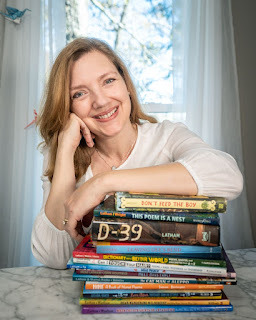 Irene LathamHello and Happy National Poetry Month!
Irene LathamHello and Happy National Poetry Month!This month we are riffing off the word "rooted."
The first thing that comes to my mind is one of my daily Mindfulness Affirmations:
I am rooted in this present moment.
There have been times in my life when I've agonized over this question: What's my PURPOSE? All these stories, poems, words...what are they FOR?
I mean, we could spend decades on those questions! And the answer may shift and change directions from year to year...
One thing I've discovered since my first book for children was released (2010) is that when I am rooted in the present moment, all those angsty "purpose" thoughts fade. My only purpose is to live each moment as fully as possible.
What a relief!
But how does one get there, to that place of peace?

Mary Oliver in her book UPSTREAM has this to say:
"'Song of Myself,' [the poem by Walt Whitman, which if you read no other poem this National Poetry Month, make it this one] with its thunder and its kisses and its implications. So hot is the fire of that poem, so bright its transformative power, that w truly need, and Whitman knew it, each of the slow, descending chords that follow. There is a madness born of too much light, and Whitman was not after madness nor even recklessness, but the tranquility of affinity and function. He was after the joyfulness, a belief in existence in which man's inner light is neither rare nor elite, but godly and common, and acknowledged. For that it was necessary to be rooted, again, in the world."
To be rooted in the world.
To stand on a sandy shore and look at the ocean.
To go barefooted in the rain.
To fall in love again with trees.
Here's a short poem to help get you there. Thanks so much for reading!
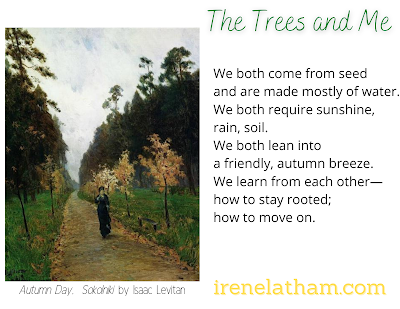
The Trees and Me
We both come from seed
and are made mostly of water.
We both require sunshine,
rain, soil.
We both lean into
a friendly, autumn breeze.
We learn from each other—
how to stay rooted;
how to let go.
- Irene Latham
April 2, 2024
Rooted in the World of Middle Grade Fiction
I’ve been interviewing a number of middle grade authors onmy other blog, Book Q&As with Deborah Kalb, and I thought I’d provide asampling of what they had to say about how their novels are rooted in aparticular place.
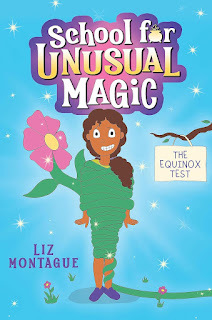
First up, Liz Montague. Her new middle grade novel, Schoolfor Unusual Magic: The Equinox Test, features a magic school based in Brooklyn.Why Brooklyn, I asked?
Montague said: “My parents met and went to school inBrooklyn (my dad’s a born and raised New Yorker) so I grew up visiting a lotand additionally my mom was an architect for NYC School Construction Authority(they build/design NYC public schools) for her entire career!”
She added, “She commuted to the city everyday from NJ and alot of her projects were in Brooklyn so I grew up hearing very detailed storiesabout Brooklyn schools. Additionally, I always wanted to be a city kid but grewup in a rural New Jersey suburb instead so this was my chance to live myfantasy.”
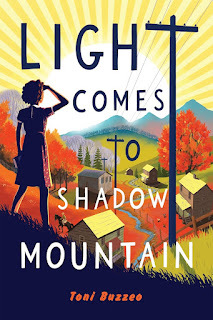
Next up is Toni Buzzeo, the author of the middle grade novel Light Comes to Shadow Mountain. It’s set in 1930s Kentucky. She said of thesetting: “It was essential to me that I capture the truth of the hardscrabblebut worthy life of the isolated mountain people of Eastern Kentucky, both theirchallenges and their blessings in living where they did in the first half ofthe 20th century.”
She continued, “I wanted to share with readers the startlingfact that in 1937 those mountains were still dark at a time when America, as awhole, existed in a very modern brightly lit age, thus offering a freshperspective on the history of the period.”
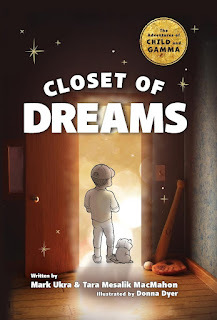
Last, we have Tara Mesalik MacMahon. She and her brother,Mark Ukra, wrote the middle grade novel Closet of Dreams, which was based on aspecific location in their childhood home.
MacMahon said: “On what inspired the book, that’s an easyone—we had a Closet of Dreams (an empty closet) in our childhood home in LosAngeles. In that closet, years and years of fantastical adventures came tolife, where Mark was ‘Child,’ a 9-year old orphan boy, and I was hisgrandmother, ‘Gamma,’ with whom Child lived.
She added: “Our dog Hilda held a key role, as did ourimaginary animal friends: a hippo, a bear, and an elephant. And so became thebook’s tag line, ‘A True Story About a Pretend World.’”
What roots your own stories to a particular place? It’sinteresting to contemplate.
--Deborah Kalb
@font-face {font-family:"Cambria Math"; panose-1:2 4 5 3 5 4 6 3 2 4; mso-font-charset:0; mso-generic-font-family:roman; mso-font-pitch:variable; mso-font-signature:-536870145 1107305727 0 0 415 0;}p.MsoNormal, li.MsoNormal, div.MsoNormal {mso-style-unhide:no; mso-style-qformat:yes; mso-style-parent:""; margin:0in; mso-pagination:widow-orphan; font-size:16.0pt; font-family:"Times New Roman",serif; mso-fareast-font-family:Arial; mso-fareast-theme-font:minor-latin; mso-font-kerning:1.0pt; mso-ligatures:standardcontextual;}.MsoChpDefault {mso-style-type:export-only; mso-default-props:yes; font-size:16.0pt; mso-ansi-font-size:16.0pt; mso-bidi-font-size:16.0pt; mso-fareast-font-family:Arial; mso-fareast-theme-font:minor-latin;}div.WordSection1 {page:WordSection1;}
April 1, 2024
News
March 29, 2024
by Charlotte BennardoEveryone knows what a rebound means...
by Charlotte Bennardo
Everyone knows what a rebound means: in basketball, it means to catch the ball when it doesn't go in the basket and make another shot. In love, it means to find a new partner/spouse/companion after a breakup. When someone says, I'll catch you on the rebound, it means to catch up with someone another time.
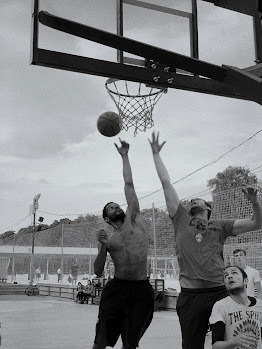 Photo by Maxim Shklyaev: https://www.pexels.com/photo/men-play...
Photo by Maxim Shklyaev: https://www.pexels.com/photo/men-play...
For me as a writer, it means that when I receive rejections from editors and agents, I don't throw in the towel and quit. I may (and usually do) throw a tantrum, but I keep on going. I keep submitting, querying, and writing. By keeping my 'head in the game' I may catch that one 'shot', that one agent or editor that wants my work- allowing me to score a win, a contract.
A failed shot, a rejection, means I have to focus on my craft, look for submission opportunities and approachable agents/editors, and mostly, believe in myself and my work. There should never be a one and done in writing. I advise beginning writers all the time, and remind myself, that one person (editor or agent), at a specific time, with one particular manuscript is not the singular answer. Just like a basketball player gets more than one chance to make other shots, so we as writers get more chances for success--if we keep our head in the game and don't let one failed shot define us.
 Photo by Wallace Chuck: https://www.pexels.com/photo/photo-of...
Photo by Wallace Chuck: https://www.pexels.com/photo/photo-of...As a writer, it's always Game Time!
Charlotte writes MG, YA, NA, and adult novels in sci fi, fantasy, contemporary, and paranormal genres. She is the author of the award-winning middle grade Evolution Revolution trilogy, Simple Machines, Simple Plans, and Simple Lessons. She co-authored the YA novels Blonde OPS, Sirenz, and Sirenz Back in Fashion. She has two short stories in the Beware the Little White Rabbit (Alice through the Wormhole) and Scare Me to Sleep (Faces in the Wood) anthologies. Having finished her MFA, she's applying what she learned and is working on several children's and adult novels, along with some short stories. She lives in NJ with her family and her floofy cat. When they trimmed the backyard tree, the crazy squirrel couple had to move out.
March 25, 2024
Two Second Rebound Rate (Holly Schindler)
My favorite scene in The Notebook is the one where Ryan Gosling's character is asking Rachel McAdams's character to choose between him and her fiance. He says to her: "You tell me when I am being an arrogant son of a bitch and I tell you when you are a pain in the ass. Which you are, 99% of the time. I'm not afraid to hurt your feelings. You have like a two second rebound rate, then you're back doing the next pain-in-the-ass thing."
I like it so much it makes the whole movie worth watching.
I think, at this point in my life, I might also have one of those two second rebound rates. But it's been fairly hard-won, after decades of taking knocks.
 It sounds beautiful and idyllic, spending your life pursuing your dream. And to be sure, if you are afforded that chance by your life circumstances, you (ahem, I) need to count your lucky stars.
It sounds beautiful and idyllic, spending your life pursuing your dream. And to be sure, if you are afforded that chance by your life circumstances, you (ahem, I) need to count your lucky stars. Lucky, yes. Easy? Nope.
When I first started writing, I felt like anything but a writer. I didn't even call myself that--I didn't feel like I had the right, without a publisher behind me. I referred to manuscripts as things rather than books. And, as a result, when my work came back to me (in the SASE envelope days), I cringed, finding it hard to look inside. It was going to hurt. The hurts kept piling until, about four years in, without a single yes from a publisher, I felt like packing it in.
The short of it is that I didn't (obviously). But the fact that I came so close shows how hard it is to rebound. At a certain point, you don't think you have it in you anymore.
This past year, when I decided to revive my artwork and become a commercial artist and surface pattern designer (while maintaining my writing career), I started calling myself an artist right from the beginning. I added it to my social media bios. I posted my pieces on IG. I took ownership of it, right from the beginning.
And I think it made a difference.
Whatever your dream, start referring to yourself by the title you're hoping to achieve but haven't yet. As silly as it seems, call yourself that title now. Because rejection doesn't stop once you get a little success. It will follow you the rest of your days. And it will hurt and it will sometimes knock the wind out of you. But there's something about taking that ownership--it really does make it easier to get back up after those most painful first knocks.
~
Holly Schindler is the author of The Junction of Sunshine and Lucky
March 23, 2024
The Hardy Imagination: Smack Dab in the Imagination by Dia Calhoun
I speak from experience. I’ve just completed the first polished draft of a new book I’ve been writing for five years. Four of those years I worked on the book for six months of the year. Last March, I knew it was time for a full-time final plunge to completion.Over those years, in the face of covid, deaths, illness, political anxiety, a blight in the garden, my imagination kept delving, kept flowering. It neither froze nor dried up.
Of course, this begs the question—how do you create a hardy imagination? For me, there are two ways. First, sheer fun. I provide good toys for my imagination to play with—reading, researching, reflection. Creative distraction! Second, I trust my imagination’s generative capacity. Over my creative lifetime, I've learned to try various ideas, characters, or descriptions without clinging to them in fear or in belief in their preciousness. I've learned to kiss many ideas goodbye and send them away. I trusted that my imagination would keep playing.
As I write this now, each time I write hardy, my writer’s ear hears the echo of the word “hearty.” Those words do resonate with each other, don’t they? Something else to play with.
May your imagination always be hardy.
March 15, 2024
Don't Forget to celebrate!
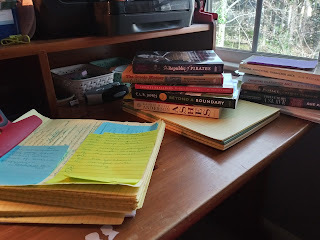
Recently, a friend shared his wisdom when another said thatwriting is hard, and asked if there was a way to make it easier. To this, myfriend said, describing his approach to writing fiction, “Write it from insidethe characters. Allow the characters to grow their own story and follow theirlead. When it is complete and you are seeking opinions about how well you wroteit, leave your ego at home and allow the comments --- even the foolish ormisguided ones --- to penetrate because they are talking about a book, notabout you. Even a fool is correct once in a while! The goal is to create a workof art that will speak well of you. Any hack can cobble together 80,000 words,but most of that kind of writing can put a shark to sleep.”
Every term, my MFA students lament this very thing. I haveto remind them that every writer carries similar worries at every stage oftheir career. In some part, it's the nature of the business itself. But it'salso a function of human nature.
It seems the core of these worries are defined by a lot ofshouldas and couldas, accompanied by a strong belief in several sacred mythsabout writing and writers. Myths, theyhope, that carry the secrets to and serve as a compass for how to succeed as awriter.
Myth: Writers only write when they are inspired.
I’m too old to wait around, hoping for some magical muse toshow up. The truth is, writers write. It seems to me that curiosity is muchmore important.
Recently I’ve been going through a phase in which I reallylike Australian TV. The scenery. The intersection of history between indigenousand penal colonies. The Māori (and the Huka!). A common plot device is cricket– whether it’s baking, mystery, supernatural or comedy, there always seems tobe a leather ball and a flat bat involved. To understand the context, I startedresearching cricket. And watching Australian cricket. (Baggy green is now myfavorite color! What a sticky wicket!) This led me to research certain cricketpersonalities, then cricket history, which led to reading more about Britishcolonialism. Which led to reading about the mid-Atlantic slave trade and themiddle passage and the slave narratives. Which led me to Caribbean uprisings.While it sounds like a rabbit hole that Lewis Carrol might envy (and it was), Ibegan noticing a seed for a story. This seed soon developed into a premise.Then it became a character. Then it became a draft.
More often it is through the act of reading and writingitself that inspiration finally decides to visit.
Myth: Writers are introverts.
There may be some truth to this. I prefer long walks toparties. I prefer languorous conversations with my flowers. Albeit, mygranddaughter is pretty good at discussing the secrets of dragonflight. Otherstravel, attend literary events, participate in writing and reading groups, joinonline discussions. Sometimes I pop into one or two events. Given my luddite nature, my relationship withsocial media is rather wobbly. (The irony that I’m writing a blog isn’t lost onme. But I did handwrite this first!) Some may be energized and go full steaminto social events, while others find it exhausting. In the end, writers needdiverse perspectives and connections to enrich their writing, but ultimately,it’s more important for you to be you.
Myth: Method X is better than Method Y.
I’m a nerd about the writing process. I find it an endlesslyfascinating topic. While I have more than a fair share of degrees andcertificates in the writing process, I still attend classes, workshops andlectures given by the best in the business. If you have the chance, I can’trecommend enough the classes given by Emma D. Dryden, Harold Underdown and Eileen Robinson, and the many offerings at Free Expressions, sponsored byLorin Oberweger and company, featuring such lecturers as Donald Maass, ChrisVogler and many others.
Whether it’s plotting versus pantsing, the hero’s journeyversus the snowflake method, or saving the cat versus the three-act narrative,editing while you go or hammering out an SFD, everyone has their own way ofengineering a story. My own process tends to follow four steps:
1. Research to get an overview of historical and socialcontexts. Besides, I like to read. You never know what treasure you’ll find.
2. Outline, because Itend to work with a cast of characters as well as historical/social elementsthat require careful staging.
3. Write that SFD, usually by hand first.
4. Revise, then revise again, then revise again, becausethis is where the real magic happens.
What makes it work for me is that I set time apart for my writingand treat it like a job. I know how busy life becomes, having worked full-time as asingle parent and maintained a household. But it is still my job to write.
Myth: Writers are excellent spellers.
Yea. Right.
Myth: Writing is easy.
Does any of this sound easy?
Just as an engineer relies on a structurally-sound blueprint– one that, according to Larry Brooks in his book, Story Engineering, requiresa plan based on proven physics and structural dynamics -- to build somethingthat will bear weight and resist the elements, so must a writer engineer astory using the literary equivalent. The technicality of the story isfundamental to its creativity. The master writers make it look easy, but behindthe scenes, it’s all sweat, blood and a few tears.
There are no easy answers. I tend to like what Margaret Dilloway suggests in The Writer Unboxed, that you have to give yourself the permission to write, and you have to give yourself your ownapproval and authentication, instead of depending on external sources. As shestates, "Nobody else can do that for you. You have to take thatpower and confidence for yourself.”
Most important, remember that it's important to celebrate thelittle things. And the big things. And the wicked goggly things, too.
Celebrating thecompletion of my SFD! You know, shitty first draft! Only 99 more to go!
Thank you for reading!
Bobbi Miller
March 12, 2024
Rebound and Recharge by Darlene Beck Jacobson
Highs and lows. Ups and downs. We all go through the roller coaster that is life. As authors it sometimes feels like the lows are winning as we face rejections, disappointment, and lack of motivation to even show up with pen in hand or hands on computer.
We love the highs. Who wouldn't? Praise, awards, great reviews can recharge our dormant batteries and give us the incentive to keep on going.
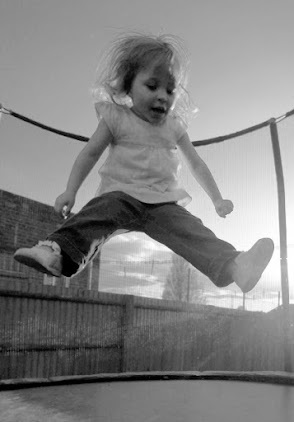
But just like in life, most of our creativity and the writing that springs from it often happens in the valley. On the everyday straightaway that hums steadily along like The Little Engine That Could.

We can't wait for the highs and we can't stop for the lows if we are to keep on going. As Irene Latham said so eloquently a few days ago, we acknowledge our disappointments, our successes and our failures. Then we get back on the writing train and see where it takes us. The ride is never the same, but it always leads to someplace interesting.
Embracing the journey with all it's ups and downs is what makes us keep on writing.
Darlene Beck Jacobson enjoys riding to places she's never been and often finds something worth noticing on these excursions.
March 11, 2024
R-E-B... R-E-B... R-E-B-O-U-N-D... Rebound!

The chant from the school bleachers echoes throughout my mind from time to time.
R-E-B... R-E-B... R-E-B-O-U-N-D, Rebound!
Back then, the chant meant only one thing: a hope that the other team would miss a free throw; then, our team would grab the basketball, take it down the court, and swish it through the net. Even though I still watch basketball and hear “rebound” at every game, the word has a whole other meaning to me. It’s something I’ve needed to do literally hundreds of times.
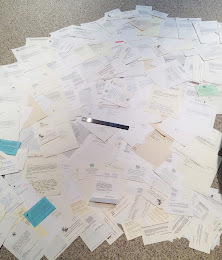 Take a look at the expanse of rejections I amassed, from agents and editors alike, before I got my first YES.* These represent the time when my learning curve was steep, when I was just starting to acquire the skills and appreciate the work it takes to micro-move a book from pretty great to publish-worthy.
Take a look at the expanse of rejections I amassed, from agents and editors alike, before I got my first YES.* These represent the time when my learning curve was steep, when I was just starting to acquire the skills and appreciate the work it takes to micro-move a book from pretty great to publish-worthy. I’d like to tell you that rebound is again limited to my basketball vocabulary, but the truth is, I’ve been slapped many times since. Sure, it stings. Sure, no balm will heals some of the wounds. But there’s this. Each time I need to brush off the hurt, take a deep breath, and start over again, I learn something new. And that works to limit most of the rebounds in my life to the basketball courts.
*Yes, that's an 18-inch ruler. But wait! I’ve amassed so many more since correspondence by USPS has morphed into email rejections and, most frustrating, when months of hearing crickets eventually mean no.Jody Feldman, the award-winning author of The Seventh Level and The Gollywhopper Games series , is currently rebounding after having licked her wounds from feedback on a story that will, undoubtedly, be stronger because of the process.
March 9, 2024
Unlocking Holistic Learning: Nurturing Minds Beyond the Classroom (Guest Post by Fahad Siddiqui)
In a world where information flows like adigital river, education stands at a crossroads. We’ve all been there—the rigidclassroom desks, textbooks filled with facts we’ll likely never use, and thepressure to memorize dates and equations. But what if there’s a better way?What if we could transform education into a dynamic journey that equips us notjust with knowledge, but with the skills to thrive in an ever-evolvinglandscape?
The Problem with theConveyor Belt ApproachOur current educational system oftenresembles a conveyor belt, churning out graduates who can recite historicalevents but struggle to apply critical thinking to real-world problems. Thefocus on standardized tests and memorization leaves little room for creativity,emotional intelligence, or practical life skills.
Holistic Learning: AParadigm ShiftHolistic learning flips the script. Itrecognizes that education isn’t just about absorbing facts; it’s aboutnurturing well-rounded individuals. Here’s how we can shift gears:
Skills Over Facts: Instead of memorizing the periodic table, let’s teach problem-solving, communication, creativity and adaptability. These skills transcend subjects and empower students to tackle any challenge. Embracing Curiosity: Curiosity is the spark that ignites lifelong learning. Let’s encourage questions, exploration, and interdisciplinary thinking. After all, the most exciting discoveries happen at the intersection of fields. Learning Beyond Walls: Classrooms are essential, but so are gardens, workshops, and community spaces. Imagine a curriculum that includes engaging with the outdoors, mindfulness, and financial literacy. Lessons such as these build a solid foundation for the future of any child. Mindfulness and Well-Being: Mental health matters. Let’s weave mindfulness practices into the fabric of education. When students learn to manage stress, cultivate empathy, and practice self-care, they become better learners and compassionate citizens.Building an EquitableSocietyHolistic learning isn’t a luxury reservedfor the privileged. It’s a right for all. By emphasizing practical skills,emotional intelligence, and community engagement, we bridge gaps and create ahealthier, safer and more equitable society.
ConclusionAs we reimagine education, let’s breakfree from the robotic mold. Let’s cultivate thinkers, creators, and empatheticproblem-solvers. Let’s build a society where well-being and critical thinkingare as essential as algebra and history. Together, we can unlock the fullpotential of our minds—beyond textbooks and into a world of holistic learning.
Remember, education isn’t just about whatwe know; it’s about who we become. We are striving to create content thatchallenges the current educational parameters and instill skills and habitsthat are beneficial for our collective wellbeing.
~
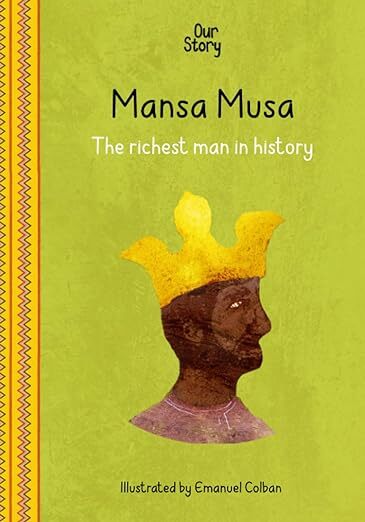
Fahad Siddiqui is the co-founder of Our Story Media Group, an innovative and holistic educational publishing company. Their mission is to foster positive, sustainable habits and behaviors through the integration of Cognitive, Physical, Communicative and Socio-Emotional teachings with proven pedagogy. Their "Our Story" book series introduces students to lesser-known global role models such as Mansa Musa, Fatima Al-Fihri and Shen Kuo. Their second series, "The Secret Alien Diaries," fosters healthy habits and promotes Social Emotional Learning (SEL) by encouraging young readers to teach alien friends how to behave on Earth. Learn more about both book series at: www.ourstory.media
Purchase Links:
Mansa Musa:https://www.amazon.com/dp/B0C91DT5CK
The Secret Alien Diaries:https://www.amazon.com/Secret-Alien-Diaries-Mission-Bedtime/dp/B0CQTC86G4/




